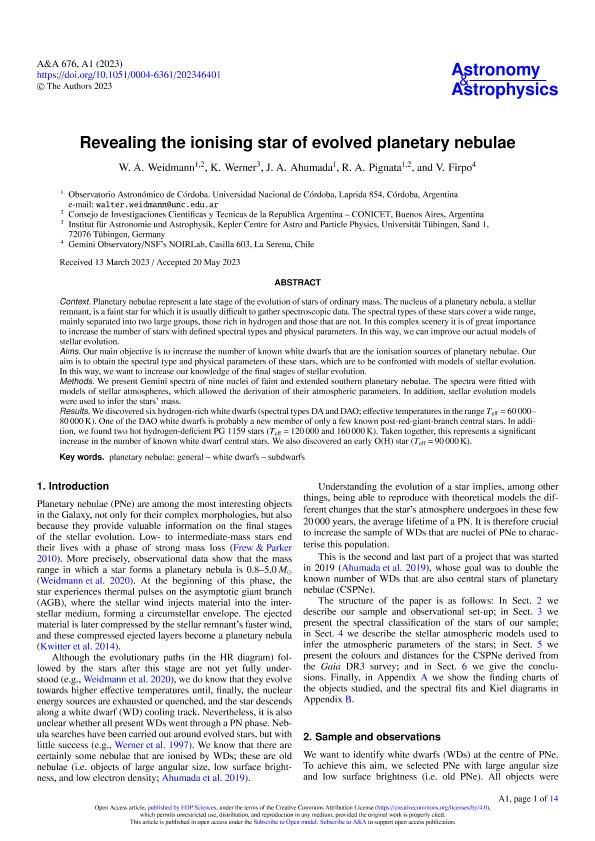Mostrar el registro sencillo del ítem
dc.contributor.author
Weidmann, Walter Alfredo

dc.contributor.author
Werner, K
dc.contributor.author
Ahumada, Javier Alejandro

dc.contributor.author
Pignata, Rafael Andrés

dc.contributor.author
Firpo, V.
dc.date.available
2024-01-31T14:28:24Z
dc.date.issued
2023-07
dc.identifier.citation
Weidmann, Walter Alfredo; Werner, K; Ahumada, Javier Alejandro; Pignata, Rafael Andrés; Firpo, V.; Revealing the ionising star of evolved planetary nebulae; EDP Sciences; Astronomy and Astrophysics; 676; 7-2023; 1-14
dc.identifier.issn
0004-6361
dc.identifier.uri
http://hdl.handle.net/11336/225347
dc.description.abstract
Context. Planetary nebulae represent a late stage of the evolution of stars of ordinary mass. The nucleus of a planetary nebula, a stellar remnant, is a faint star for which it is usually difficult to gather spectroscopic data. The spectral types of these stars cover a wide range, mainly separated into two large groups, those rich in hydrogen and those that are not. In this complex scenery it is of great importance to increase the number of stars with defined spectral types and physical parameters. In this way, we can improve our actual models of stellar evolution. Aims. Our main objective is to increase the number of known white dwarfs that are the ionisation sources of planetary nebulae. Our aim is to obtain the spectral type and physical parameters of these stars, which are to be confronted with models of stellar evolution. In this way, we want to increase our knowledge of the final stages of stellar evolution. Methods. We present Gemini spectra of nine nuclei of faint and extended southern planetary nebulae. The spectra were fitted with models of stellar atmospheres, which allowed the derivation of their atmospheric parameters. In addition, stellar evolution models were used to infer the stars'mass. Results. We discovered six hydrogen-rich white dwarfs (spectral types DA and DAO; effective temperatures in the range Teff = 60 000- 80 000 K). One of the DAO white dwarfs is probably a new member of only a few known post-red-giant-branch central stars. In addition, we found two hot hydrogen-deficient PG 1159 stars (Teff = 120 000 and 160 000 K). Taken together, this represents a significant increase in the number of known white dwarf central stars. We also discovered an early O(H) star (Teff = 90 000 K).
dc.format
application/pdf
dc.language.iso
eng
dc.publisher
EDP Sciences

dc.rights
info:eu-repo/semantics/openAccess
dc.rights.uri
https://creativecommons.org/licenses/by-nc-sa/2.5/ar/
dc.subject
PLANETARY NEBULAE: GENERAL
dc.subject
SUBDWARFS
dc.subject
WHITE DWARFS
dc.subject.classification
Astronomía

dc.subject.classification
Ciencias Físicas

dc.subject.classification
CIENCIAS NATURALES Y EXACTAS

dc.title
Revealing the ionising star of evolved planetary nebulae
dc.type
info:eu-repo/semantics/article
dc.type
info:ar-repo/semantics/artículo
dc.type
info:eu-repo/semantics/publishedVersion
dc.date.updated
2024-01-29T15:20:51Z
dc.journal.volume
676
dc.journal.pagination
1-14
dc.journal.pais
Francia

dc.description.fil
Fil: Weidmann, Walter Alfredo. Universidad Nacional de Córdoba. Observatorio Astronómico de Córdoba; Argentina. Consejo Nacional de Investigaciones Científicas y Técnicas. Centro Científico Tecnológico Conicet - Córdoba; Argentina
dc.description.fil
Fil: Werner, K. Universidad Tubinga; Alemania
dc.description.fil
Fil: Ahumada, Javier Alejandro. Universidad Nacional de Córdoba. Observatorio Astronómico de Córdoba; Argentina
dc.description.fil
Fil: Pignata, Rafael Andrés. Universidad Nacional de Córdoba. Observatorio Astronómico de Córdoba; Argentina. Consejo Nacional de Investigaciones Científicas y Técnicas. Centro Científico Tecnológico Conicet - Córdoba; Argentina
dc.description.fil
Fil: Firpo, V.. No especifíca;
dc.journal.title
Astronomy and Astrophysics

dc.relation.alternativeid
info:eu-repo/semantics/altIdentifier/doi/http://dx.doi.org/10.1051/0004-6361/202346401
Archivos asociados
